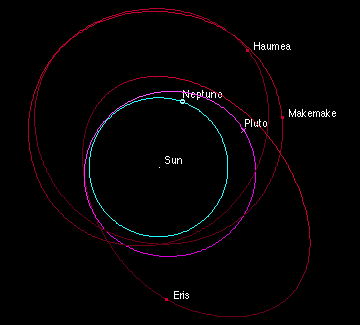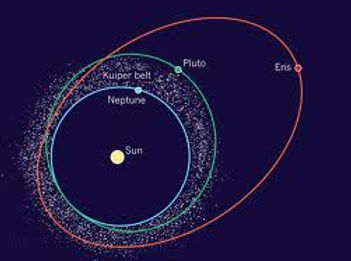
Dwarf Planet
In our solar system, a dwarf planet is a celestial body that
1) must be in orbit around the sun,
2) has sufficient mass to be round in shape,
3) has NOT "cleared the neighborhood" around its orbit of other objects,
4) and is not a satellite.
(definition by IAU in 2006)

Ceres
-
Discovered in 1801 and was thought to be a planet at the time
-
Distance from the sun: less than 5 AU
-
Approximat Diameter: 950 km
-
Period of Revolution: 4.6 years
-
Period of Rotation: about 9 hours
-
Number of moons: none
-
Smallest dwarf planet
-
Only dwarf planet in the inner solar system
-
Largest asteroid in the asteroid belt between Mars and Jupiter
-
Contains 1/3 of the mass in the asteroid belt
-
Rock-ice body
-
Thought to have a water-ice layer


Pluto
Interesting Facts:
-
Pluto's orbit crosses Neptune's orbit
-
Pluto's moon, Charon, is nearly as large as Pluto itself.
-
Pluto and Charon are tidally locked (i.e., always face each other).
-
Pluto is very cold (40 K).
Distance from Sun: 5890 km
Orbital Speed: 4.7 km/s
Period of rotation (length of day): 7 days
Period of revolution (length of year): 248 years
Type of Rotation: Retrograde
Approximate diameter: 2,390 km
Surface gravity: 7%
Number of moons: 1 named Charon


Makemake
-
Discovered in 2005
-
Located in Kuiper Belt
-
Distance from Sun: 52.3 AU
-
Period of Revolution (length of year): 310 years
-
Period of Rotation: unknown
-
Approximate diameter: about 2/3 size of pluto
-
Number of moons: none
-
Frozen nitrogen, methane and ethane found on surface
-
Appears red in color


Haumea
-
Discovered in 2004
-
Located in Kuiper Belt
-
Distance from Sun: 43.3 AU
-
Period of Revolution (length of year): 285 years
-
Period of Rotation: about 4 hours
-
Approximate diameter: about same size as pluto
-
Number of moons: 2
-
Strong crystalline water ice features on surface
-
Shape of an ellipsoid


Eris
-
Discovered in 2005
-
Distance from the sun: 3 times farther from the sun than Pluto
-
Approximate Diameter: 2,326 km
-
Most massive known dwarf planet. 27% more mass than Pluto
-
Period of Revolution: 557 years
-
Period of Rotation: estimated over 8 hours
-
Number of moons: 1 named Dysnomia
-
Eris and Dysnomia are currently the most distant known natural bodies in our solar system (except some comets)
-
Not much is known about the surface
-
Believed to be composed of methane
-
Gray in color
